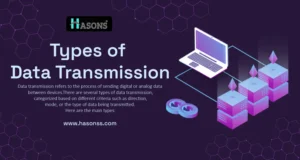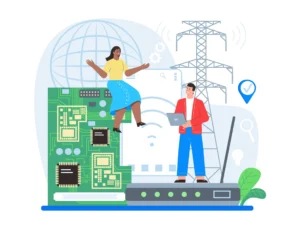Data Transmission
In the present generation, with communication technology, becoming imperial data transmission is one of the essentials of the digital society. Some of the areas that will be addressed by this guide will include data transmission. We will define its meaning and discuss how such occurrences come into being. We will also be able to talk about what type of data transmission and also why data transmission is crucial, the strengths and weaknesses of data transmission.
This refers to the process of transferring digital data from one gadget to another via a channel of communication. It is useful for letting me convey and receive text, pictures, sounds, or video. It occurs across platforms and networks enhancing our communication and interaction in various tasks. Using this guide, you’re going to have a great understanding of what data transmission is and how data transmission takes place. You shall be equipped with the confidence needed to succeed in the modern world of business run through digital platforms.
What is Data Transmission?
Data transmission therefore is the process by which data or information is sent from one location to another through a communication channel. In essence, it is converting a word written in a document, picture, voice, or video, into a digital format, respectively. Then, this data moves through a communication channel either by wired or wireless mode there to where it is necessary. In this manner, info moves from one device to the other making it possible for us to collaborate or communicate inter With Tag: Online collaboration and interactions.
Thus, the term data transfer encompasses all stages through which data goes in the journey. From the time it is created or gathered to the time it is read or heard, all these are helpful in the present means of communication and gadgets. conferencing is effective and efficient for business communication regardless of our geographical proximity and it accommodates several technologies and networks.
How Does Data Transmission Work?
Transmission is one of the procedures that we use in Data Communication. That is why it has several steps to make it work right. First, the data is then converted to electronic format for sending through encoding. This transforms the info into a signal that can travel through a channel. Next, the coded data is modulated according to the type of network, wired or wireless. This makes it ready to go through the channel.
The signal shifts to the other device. At the other end, the carrier signal is demodulated to recover the original data transmitted. This is how the original message is reconstructed after it has been distorted by frequency modulation. Next, the data is decoded. It has been converted back into a form that is useful for the other device. This whole process is made much smoother by many protocols and technologies. Understanding how this process occurs is crucial in optimizing the usage of contemporary communication and technology.
Types of Data Transmission
With regard to data transmission, there are three categories.
These are simplex, half-duplex, and full-duplex. Understanding how each type works assists in sharing information appropriately.

Simplex data transmission transmits data in only one direction. It runs from the sender to the receiver. This is like how radio and TV signals work.
Half-duplex data transmission allows both directions for data transfer but not simultaneously. Devices switch transmitting/receiving roles. It is about to be similar to how you would use two-way radios or walkie-talkies.
Full-duplex data transmission is the highest type, allowing both stations to transmit concurrently. It is such that all participants can simultaneously send and receive information interchangeably. It is what is used in phones today, and all the things on the internet.
| Type of Data Transmission | Description | Examples |
| Simplex | Unidirectional, information flows in a single direction from sender to receiver. | Receiver, Radio, television signals |
| Half-Duplex | Bi-directional communication, but only one device can transmit at a time. | Walkie-talkies, two-way radios |
| Full-Duplex | Simultaneous bi-directional communication, where both sender and receiver can transmit and receive data at the same time. | Telephone networks, internet-based applications |
Advantages and Disadvantages of Data Transmission
Communication or transfer of data as understood here has shifted the manner in which information dissemination occurs. This allows the delivery of information at high speed, and this enables organized workflow among a team even if the team members are located in different regions. Based on this analysis, it is such a blessing, especially for the transportation of large files, and enhances the speed of working. The utilization of data transmission enables one to gain information from any part of the world that has the internet. This is very helpful when cases like COVID-19 are rampant in society. Although for many it becomes obsolete for working and studying from any place it’s most necessary.
However, the above communication process has some dangers attached to it especially when sending data. Confidentiality also has its vulnerability because it is conceivable that the information transferred through this channel may be intercepted by unauthorized persons. In other words, to save your business from such threats, it is vital to use reliable security and encryption. Network may also hinder in sending data and this may lead to some delays due to network breakdowns or some technical grounds. However, despite these shortcomings, there are many benefits of data transfer. Some experts also consider it the present form of communication and work style. Technology is always seeking to improve ways of getting data across since it is always needed in so many ways.
Function: Technology security serves the function of keeping all the information and data we send across the Internet secure from hackers and other malicious entities.
| If you are reading Data Transmission then also check our other blogs: | |
| Computer Virus | First Electronic Computer |
| Components of computer network | Types of scanner |
Data Transmission
- What is meant by data transmission?Thus, data transmission would denote the process through which data are conveyed from one point to the other within a communication link such as a cable or through a wireless link.
- What are the three types of data transmission?The three types of data transmission are:
- Simplex: It is a one–way message and does not allow feedback since it only moves in one direction, from the source to the destination.
- Half-duplex: Both parties can send and receive data at the same time, although the action cannot occur at the same time. It can either send or receive, but cannot do both at once.
- Full-duplex: Data can be sent and received concurrently, making the use of channels that involve both incoming and outgoing data possible.
- What is simple data transmission?Half duplex data communication is a form of data communication that only occurs in one direction and at one time in the other, for example from a transmitter to a receiver as there is no provision for the reverse.
- How is digital data transmitted?Conveyance of information through digital technology is done in terms of Data flow in Binary mode; the figure is made of a string of 0 and 1. It often makes use of digital signals which can specifically be in the form of electrical pulses whose on-off state may be distinguished, light pulses, or radio waves. These signals are then digital or analog converted and encoded to fit into the various communication channels which could be cables or airwaves.

